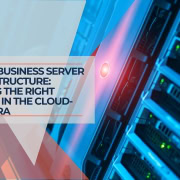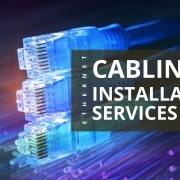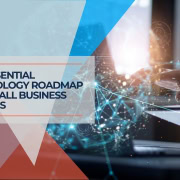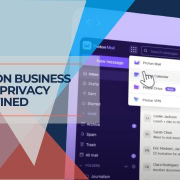A Strategic Guide to Overcoming the Top 4 IT Challenges for SMBs
Published: 2023-03-24 | Last updated: October 2025
Key Takeaway: Small and medium-sized businesses face four critical IT challenges: evolving cybersecurity threats, complex data management, infrastructure modernization, and resource constraints. Success requires a strategic approach combining proactive security measures, cloud-first solutions, and the right mix of internal capabilities and external expertise.
Small and medium-sized businesses operate in an increasingly complex technology landscape where IT challenges can make or break operational success. Unlike large enterprises with dedicated IT departments and substantial budgets, SMBs must navigate sophisticated technology requirements with limited resources while maintaining a competitive advantage.
The stakes have never been higher. A single cybersecurity incident can cost an SMB an average of $200,000, while outdated infrastructure can limit growth opportunities and employee productivity. However, businesses that address these challenges strategically often discover competitive advantages and operational efficiencies that drive long-term success.
Understanding these challenges is the first step toward developing a comprehensive security and technology strategy that protects your business while enabling growth.
Table of Contents
- 1 1. Cybersecurity Threats and Evolving Attack Vectors
- 2 2. Data Management and Compliance Complexity
- 3 3. Infrastructure Modernization and Scalability
- 4 4. IT Support and Resource Management
- 5 Developing Your IT Strategy: A Practical Framework
- 6 Frequently Asked Questions
- 6.0.1 How much should SMBs budget for IT as a percentage of revenue?
- 6.0.2 Should SMBs hire internal IT staff or rely on managed service providers?
- 6.0.3 How can SMBs stay current with cybersecurity threats without dedicated security teams?
- 6.0.4 What's the best approach for cloud migration when resources are limited?
- 6.0.5 How can SMBs ensure compliance with data protection regulations?
- 6.0.6 What emerging technologies should SMBs prioritize for competitive advantage?
1. Cybersecurity Threats and Evolving Attack Vectors
The Modern Threat Landscape for SMBs
Cybercriminals increasingly target small and medium-sized businesses, viewing them as easier targets with valuable data but fewer security resources. Modern threats extend far beyond traditional malware to include sophisticated social engineering, supply chain attacks, and AI-powered phishing campaigns that can fool even security-aware employees.
The threat landscape has evolved significantly with the rise of ransomware-as-a-service, where criminal organizations provide turnkey attack tools to less technical actors. This democratization of cybercrime means SMBs face the same advanced threats as large corporations but often with a fraction of the defensive resources.
Critical Reality Check
SMBs experience data breaches at higher rates than large enterprises. Studies show that smaller businesses often take longer to detect and respond to security incidents, increasing the potential damage and recovery costs.
Comprehensive Security Framework for SMBs
Essential Security Layers
Endpoint Protection and Detection: Deploy enterprise-grade endpoint protection that includes behavioral analysis and threat hunting capabilities. Modern solutions can detect zero-day attacks and provide automated response capabilities that don't require dedicated security staff.
Email Security Beyond Basic Filtering: Implement advanced email security that analyzes links in real time, detects impersonation attempts, and provides user-friendly reporting of suspicious messages. Consider solutions that integrate with your existing Microsoft 365 email infrastructure for seamless deployment.
Network Segmentation and Monitoring: Separate critical business systems from general user networks. This limits the spread of potential infections and provides better visibility into unusual network activity.
Identity and Access Management: Implement single sign-on solutions with multi-factor authentication across all business applications. Modern identity platforms can provide enterprise-level security while simplifying the user experience.
- Conduct quarterly security assessments using automated vulnerability scanners and manual reviews of access controls and security policies
- Implement security awareness training with simulated phishing campaigns and regular updates on emerging threats
- Establish incident response procedures with clear roles, communication plans, and recovery priorities
- Maintain offline backup systems that cannot be accessed through network connections, protecting against ransomware attacks
- Deploy zero-trust network principles where every access request is verified, regardless of location or device
2. Data Management and Compliance Complexity
The Data Challenge for Growing Businesses
Modern SMBs generate and collect vast amounts of data across multiple systems, applications, and devices. This data often exists in silos, making it difficult to gain insights, ensure consistency, or maintain compliance with privacy regulations. The challenge intensifies as businesses grow and add new systems, creating integration complexities that can overwhelm limited IT resources.
Regulatory compliance adds another layer of complexity, with requirements varying by industry, location, and business activities. GDPR, CCPA, HIPAA, and industry-specific regulations create overlapping obligations requiring systematic data governance and protection approaches.
Modern Data Management Strategies
Cloud-First Data Architecture: Adopt cloud platforms that provide built-in data governance, automated backups, and compliance tools. Cloud solutions offer enterprise-level capabilities at SMB-friendly pricing models while reducing the burden of infrastructure management.
Unified Data Platforms: Implement platforms that can integrate data from multiple sources, providing single-pane-of-glass visibility into business operations. Modern solutions offer no-code integration options that don't require specialized technical skills.
Automated Compliance Monitoring: Deploy tools that continuously monitor data handling practices, flag potential compliance issues, and generate audit reports. These solutions can significantly reduce the manual effort required to maintain regulatory compliance.
Practical Implementation Framework
| Data Category | Storage Strategy | Access Controls |
|---|---|---|
| Customer Data | Encrypted cloud storage with geographic restrictions | Role-based access with audit logging |
| Financial Records | Secure cloud with automated retention policies | Multi-factor authentication required |
| Operational Data | Hybrid cloud with local caching | Department-based permissions |
| Backup Systems | Multiple cloud regions plus offline storage | Administrative access only |
Effective data management requires understanding the complete data lifecycle, from creation and processing to archival and deletion. Businesses should implement data classification systems that automatically apply appropriate security controls and retention policies based on data sensitivity and regulatory requirements.
3. Infrastructure Modernization and Scalability
Balancing Current Needs with Future Growth
SMBs face unique infrastructure challenges as they must balance immediate operational needs with future scalability requirements, all while managing limited budgets and technical expertise. Legacy systems often create bottlenecks that limit productivity and growth opportunities, but wholesale infrastructure replacement can be prohibitively expensive and disruptive.
The shift toward remote and hybrid work models has further complicated infrastructure requirements, demanding solutions that provide secure access to business applications from any location while maintaining performance and reliability standards.
Strategic Modernization Approach
Cloud Migration Strategy: Develop a phased approach that prioritizes applications based on business impact and technical complexity. Start with less critical systems to build experience and confidence before migrating mission-critical applications. When evaluating providers, consider the comprehensive factors outlined in our cloud computing security and reliability guide.
Hybrid Infrastructure Models: Implement solutions that combine on-premises systems with cloud services. This allows businesses to maintain control over sensitive data while leveraging cloud scalability for other applications.
Software-Defined Infrastructure: Adopt virtualization and containerization technologies that provide flexibility and resource optimization without requiring massive hardware investments.
Implementation Phases and Priorities
Phase 1: Foundation (Months 1-3)
Assess current infrastructure, identify immediate security vulnerabilities, and implement basic email and file sharing cloud services. Establish network monitoring and backup systems.
Phase 2: Core Applications (Months 4-8)
Migrate or modernize core business applications, implement unified communication platforms, and establish remote access capabilities with proper security controls.
Phase 3: Advanced Capabilities (Months 9-12)
Deploy advanced analytics platforms, implement automation tools, and establish disaster recovery capabilities that meet business continuity requirements.
- Prioritize solutions with built-in scalability that can grow with your business without requiring complete replacement
- Implement infrastructure monitoring tools that provide visibility into performance, capacity, and potential issues
- Establish change management processes that ensure updates and modifications don't disrupt business operations
- Plan for redundancy and failover in critical systems to minimize downtime and maintain business continuity
- Document all infrastructure components and dependencies to support troubleshooting and future planning
4. IT Support and Resource Management
The Resource Allocation Challenge
SMBs typically lack dedicated IT departments, leaving technology management to employees whose primary responsibilities lie elsewhere. This creates a challenging dynamic where critical IT decisions are made by individuals who may not have comprehensive technical expertise. At the same time, day-to-day IT support needs can overwhelm limited internal resources.
The complexity of modern business technology has grown exponentially, requiring expertise across cybersecurity, cloud platforms, compliance, networking, and emerging technologies like artificial intelligence and automation. Few SMBs can afford to maintain in-house expertise across all these domains.
Strategic Resource Management
Managed Service Provider Partnerships: Develop relationships with MSPs that can provide comprehensive IT support, from routine maintenance to strategic planning. Look for providers that offer transparent pricing, proactive monitoring, and expertise in your industry.
Internal Capability Development: Invest in training key employees on essential IT skills while maintaining clear boundaries between internal responsibilities and external expertise requirements.
Technology Standardization: Reduce complexity and support requirements by standardizing on specific platforms and vendors where possible, while maintaining flexibility for specialized needs.
Building Effective IT Support Models
| Support Level | Internal Capabilities | External Support |
|---|---|---|
| Level 1 – Basic Issues | Password resets, basic troubleshooting, and user account management | Remote support portal, knowledge base access |
| Level 2 – Technical Issues | Application configuration, basic network issues | MSP technical support, remote diagnostics |
| Level 3 – Complex Problems | Business process knowledge, vendor coordination | Specialist consultants, vendor escalation |
| Strategic Planning | Business requirements, budget planning | IT strategy consultants, technology assessments |
Effective IT support requires clear communication channels, defined escalation procedures, and regular performance monitoring. Businesses should establish service level agreements with external providers while maintaining internal capabilities for immediate business needs.
Emerging Technology Integration
SMBs must also navigate integrating emerging technologies like artificial intelligence, automation platforms, and advanced analytics tools. These technologies offer significant competitive advantages but require careful evaluation and implementation to avoid disruption and ensure positive returns on investment.
The key is approaching new technology adoption strategically, focusing on solutions that address specific business challenges rather than adopting technology for its own sake. Consider how modern security approaches, such as those outlined in our zero-trust security guide, can provide both immediate security benefits and long-term scalability.
Developing Your IT Strategy: A Practical Framework
Successfully addressing these four IT challenges requires a systematic approach that balances immediate needs with long-term strategic objectives. The most effective SMBs treat IT as a business enabler rather than a necessary expense, investing in solutions that provide measurable returns through improved efficiency, enhanced security, and competitive advantages.
Strategic Planning Process
Business Alignment Assessment: Evaluate how current IT challenges impact business objectives, customer satisfaction, and growth opportunities. Quantify the costs of inaction versus the investments required for improvement.
Risk Prioritization: Identify which IT challenges pose the most significant risks to business continuity and competitive position. Focus initial efforts on areas with the highest potential impact.
Resource Allocation Strategy: Develop realistic budgets and timelines that account for both direct costs and indirect impacts such as staff training and process changes.
Success Measurement Framework: Establish clear metrics for evaluating IT investments' effectiveness, including technical performance indicators and business outcome measures.
The most successful SMBs approach IT challenges as interconnected elements of a comprehensive business strategy. Security improvements support data management initiatives, infrastructure modernization enables better support models, and effective resource management ensures sustainable growth.
Consider how modern networking solutions, such as those detailed in our business VPN evaluation guide, can address multiple challenges simultaneously by improving security, enabling remote work, and simplifying network management.
Frequently Asked Questions
How much should SMBs budget for IT as a percentage of revenue?
Most SMBs should allocate between 6-10% of revenue to IT, with higher percentages for technology-dependent businesses. This includes both operational costs and strategic investments. The key is ensuring IT spending aligns with business growth objectives rather than focusing solely on percentage targets.
Should SMBs hire internal IT staff or rely on managed service providers?
The optimal approach typically combines both internal capabilities and external expertise. Maintain internal staff for immediate business needs and user support, while partnering with MSPs for specialized technical expertise, strategic planning, and 24/7 monitoring capabilities that would be cost-prohibitive to maintain internally.
How can SMBs stay current with cybersecurity threats without dedicated security teams?
Focus on automated security solutions that provide enterprise-level protection without requiring specialized staff. Implement security awareness training programs, establish relationships with cybersecurity-focused MSPs, and participate in industry threat intelligence sharing programs relevant to your business sector.
What's the best approach for cloud migration when resources are limited?
Start with non-critical applications to build experience and confidence, then gradually migrate more important systems. Prioritize cloud services that provide immediate benefits such as improved collaboration, automated backups, and enhanced security. Consider hybrid approaches that allow a gradual transition while maintaining control over sensitive data.
How can SMBs ensure compliance with data protection regulations?
Implement data governance frameworks that classify information based on sensitivity and regulatory requirements. Use cloud platforms with built-in compliance tools, establish clear data handling procedures, and conduct regular audits. Consider working with compliance-focused consultants for initial framework development.
What emerging technologies should SMBs prioritize for competitive advantage?
Focus on technologies that address specific business challenges rather than adopting new solutions for their own sake. When implemented strategically, artificial intelligence tools for customer service and data analysis, automation platforms for routine tasks, and advanced analytics for business insights typically provide the highest returns for SMBs.











Leave a Reply
Want to join the discussion?Feel free to contribute!